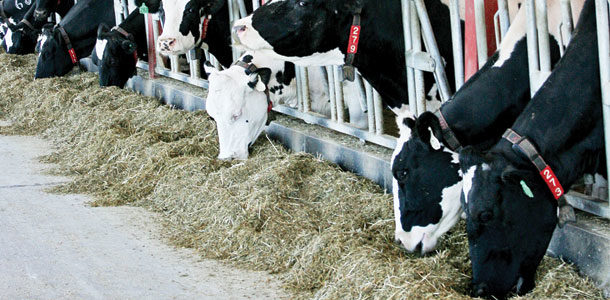Lowering prepartum dietary cation-anion difference (DCAD) in the three weeks prior to calving to reduce postpartum metabolic disease is a tried and true strategy with proven success. This nutritional approach has repeatedly been shown to reduce incidence of health challenges like retained placentas and hypocalcemia, which are two causes of expensive and significant reductions in reproductive performance and milk production.
However, in order to reduce social and nutrition stress from multiple ration changes, or due to facility limitations, some dairies choose to manage a one-group dry period strategy – which would mean feeding negative DCAD levels longer than the traditional 21 days.
This concern has kept some operations from reaping the benefits of prepartum diets with lower DCAD levels. Since producers and nutritionists have been unsure as to whether the feeding strategy was effective in the longer term, these dairies declined to adopt prefresh diets with lower DCAD levels.
New research from the University of Minnesota published in the September 2013 Journal of Dairy Science offers insight into questions about when to implement negative DCAD diets.
Results show that feeding negative DCAD diets for as long as 42 days has a positive effect on blood calcium status and milk production. This means more dairies can readily take advantage of this effective nutrition strategy to improve transition cow health and performance.
What’s the significance of DCAD?
DCAD measures the difference between positively charged cations (sodium and potassium) and negatively charged anions (chloride and sulfur) in a cow’s diet.
DCAD = (Na + K) – (Cl +S)
The optimum DCAD range for prepartum cows is -8 to -12 meg per 100 g ration dry matter.
But what does DCAD mean to a cow?
More than 80 years ago, researchers began to explore the inter-relationships between minerals, their impact on acid-base status and, eventually, numerous metabolic processes. They learned that blood pH is ultimately determined by the number of cation and anion charges absorbed in the blood.
Therefore, if more anions than cations enter a cow’s blood stream from her digestive tract, blood pH will decrease. By 1962, it was also discovered that a diet that reduced blood pH caused the concentration of blood calcium to increase and reduced the incidence of clinical hypocalcemia, or milk fever.
This is important because the onset of lactation causes a severe and rapid drain on blood calcium in order to produce milk.
If this blood calcium is not replaced as rapidly as it is reduced, via bone calcium release or intestinal absorption of calcium, cows will become hypocalcemic. Reducing DCAD to negative values helps prevent this rapid decline in blood calcium at calving.
Back to the current research
While there is convincing evidence to support lowered dietary prepartum DCAD levels, the question remained as to recommendations for feeding regimens. The results from the University of Minnesota study offer the following insight.
In the study, cows were fed:
• A negative DCAD (−16 meq per 100 g of dry matter) for 21 days before calving
• A negative DCAD (−16 meq per 100 g of dry matter) for 42 days before calving
• A positive DCAD (+12 meq per 100 g of dry matter) for 42 days before calving
Results indicated:
• Overall, cows in both groups fed the negative DCAD diet tended to have greater postpartum total blood calcium compared with cows fed the positive DCAD diet.
• Cows fed negative DCAD for 42 days prepartum tended to have greater postpartum total blood calcium than cows fed negative DCAD for 21 days prepartum.
• Feeding a negative DCAD diet for 21 days prepartum resulted in higher milk yield during the first 56 days of lactation compared with cows fed a positive DCAD diet prepartum.
• Milk production for cows fed negative DCAD prepartum diets for 42 days was similar to the 21-day treatment.
Practical applications
The research reinforced what was already known about lowering DCAD levels in prefresh diets but also added these practical applications to producers’ toolboxes:
• The confirmation that cows can receive negative DCAD diets longer than 21 days while sustaining positive outcomes can mean fewer pen moves for large herds because they don’t need to split prefresh groups.
• Results also mean producers who do not have facilities that allow multiple prefresh groups can more easily adopt this nutritional management strategy for improved overall transition cow health and performance. PD
References omitted due to space but are available upon request. Click here to email an editor.
PHOTO
Results show that feeding negative DCAD diets for as long as 42 days has a positive effect on blood calcium status and milk production. This means more dairies can readily take advantage of this effective nutrition strategy to improve transition cow health and performance. Photo by PD staff.

Elliot Block
Senior Manager of Technology
Arm & Hammer Animal Nutrition






